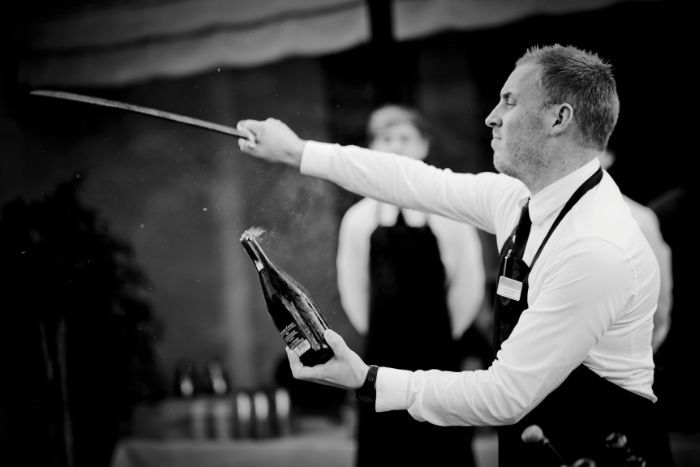Sabrage: The Spectacle of Sparkling Wine
Discover the art of sabrage, its history and how to turn the uncorking of a sparkling wine into a unique experience.

There are gestures that transcend the functional and become symbolic. One of them is sabrage, the almost theatrical art of opening a bottle of champagne (or cava) with a sword. An act that continues to arouse amazement, admiration... and many questions.
At Vinissimus, where we work every day with small producers, passionate sommeliers and thousands of customers who experience wine as an experience, we know that a bottle is not just a drink: it is a moment, a ritual, a shared story. And sabrage is part of that collective imagination that makes wine much more than just a drink.
An origin with a Napoleonic flavour
History places the birth of sabrage in France at the beginning of the 19th century, during the Napoleonic campaigns. According to legend, the hussars — cavalrymen — opened bottles of champagne with their sabres after victory, mounted on horseback and without dismounting.
Champagne was then a symbol of triumph, and to open it in this way was an act of pride and celebration.
More than two centuries later, this gesture survives, not on the battlefield, but at celebrations, weddings, events and private tastings. And far from being an extravagance, it has found its place as a ritual that combines precision, elegance and a theatricality that continues to fascinate entire generations.
What is sabrage?
Sabrage consists of opening a bottle of sparkling wine by sliding a sabre —or a blunt-edged object— down the neck of the bottle until it hits the ‘goût’ (the upper part of the neck, just below the metal crown). The pressure of the wine —more than 6 atmospheres— does the rest: the cork and the glass ring come out in a clean and spectacular way.
Not all bottles are suitable. A sparkling wine made using the traditional method is required, as well as a suitable temperature (between 4 and 6 ºC) and, of course, a quality glass bottle, capable of withstanding the pressure and ensuring a clean cut.
_______________________________________________________________________
Related articles
_______________________________________________________________________
In our experience, we have seen how even some of our most long-standing customers are surprised to discover that not all cavas or champagnes can be safely used for this practice.
Elegance, but also technique and safety
Although sabrage is visually striking and highly instagrammable, it is worth remembering that it is not a simple decorative gesture. It requires technique, care and common sense. The bottle must be held firmly, tilted at about 45 degrees, and the sword must be slid decisively, following the line of the neck.
Our recommendation as wine professionals is clear: if you have no experience, it is better to leave it in the hands of experts. Many of the wineries we work with offer this experience as part of their tours, in a safe and educational way. We have attended some of these sessions and we can say that, when guided well, they are truly memorable.
Sabrage as an experience: more than a gesture, a value proposition
In the wine sector, every detail counts. From the label to the serving temperature, everything communicates. And for those of us who work in this world — whether in production, distribution or online sales — the art of sabering wine represents a real opportunity to transform an everyday moment into an extraordinary experience.
£10
Special offer available for a minimum purchase of £99. Discount voucher valid for four weeks from issue date. Cannot be used in conjunction with other promotions except for the free delivery special offer.
Some wineries have made it part of their premium visits; others use it in presentations of new vintages or as a welcome ceremony.
Is it possible to do it at home?
Yes, but always responsibly. Although there are tutorials and accessories designed for domestic sabrage, it is advisable to take extreme precautions. An interesting alternative is to give a bottle specially prepared for sabrage, accompanied by an explanatory note or even a wine tourism experience where you can learn the technique in a controlled environment.
The final toast
Sabrage is not just a historical curiosity or a passing fad. It is a way of paying homage to sparkling wine and its place at our celebrations. A gesture that, when executed well, elevates any occasion and leaves a mark on those who witness it.
Because in the end, although the flavour is the most important thing, at Vinissimus we know that the way in which we open a bottle is also part of the pleasure of sharing it.
And if there is a sabre involved, there should be a good story behind it.